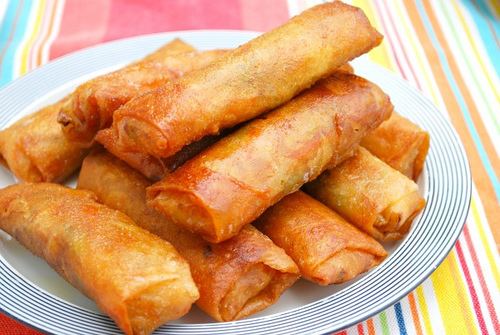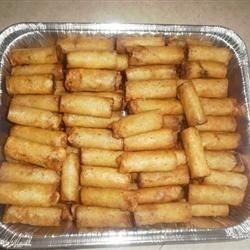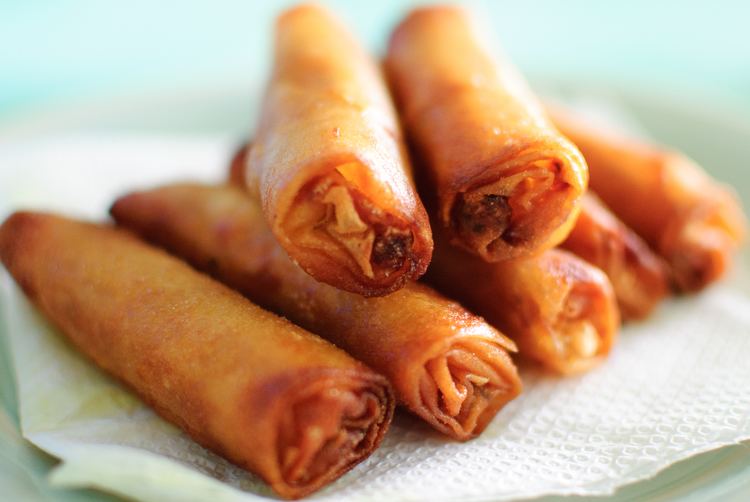Variations Fried or fresh | ||
 | ||
Alternative names Loempia, Loenpia, Ngohyong Serving temperature hot or room temperature Similar Pancit, Sinigang, Philippine adobo, Kare‑kare, Sisig | ||
Indonesian snack lumpia basah happy indonesia
Lumpia is a spring roll of Chinese origin commonly found in Indonesia and the Philippines. It is a savoury snack made of thin crepe pastry skin called "lumpia wrapper" enveloping a mixture of savoury fillings, consists of chopped vegetables (carrots, cabbages, green beans, bamboo shoots and leeks) or sometimes also minced meat (chicken, shrimp, pork or beef). It is often served as an appetizer or snack, and might be served deep fried or fresh (unfried). Lumpia is quite similar to fresh popiah or fried spring rolls popular in Southeast Asia.
Contents
- Indonesian snack lumpia basah happy indonesia
- Lumpia snack recipes from thai healthy and tasty recipes
- Etymology origin and history
- Indonesia
- Lumpia Semarang
- Lumpia Surabaya
- Lumpia Goreng
- Lumpia Basah
- Lumpia Mini
- Fresh Lumpia
- Lumpiang hubad
- Lumpiang Shanghai
- Fried lumpia
- Lumpiang ubod
- Turon
- The Netherlands
- Popularity
- References
In Indonesia lumpia has become a favorite snack, and is known as a street hawker food in the country. In the Philippines lumpia is one of the most common dishes found in any kind of gathering celebration.
In the Netherlands and Belgium, it is spelled loempia which is the old Indonesian spelling for lumpia and has also become the generic name for "spring roll" in Dutch and French. A variant is the Vietnamese lumpia, wrapped in a thinner piece of pastry, in a size close to a spring roll though, the wrapping closes the ends off completely, which is typical for lumpia. In Venezuela, it is spelled "lumpia" and was introduced by the Chinese who migrated to South America.

Lumpia snack recipes from thai healthy and tasty recipes
Etymology, origin and history

The term lumpia derives from Hokkien lunpia (Chinese: 潤餅; pinyin: rùnbǐng; Pe̍h-ōe-jī: jūn-piáⁿ, lūn-piáⁿ), which is an alternate term for popiah. Spring rolls of different shapes, sizes and fillings have been a popular snack in East Asia and Southeast Asia for centuries. It is believed that the spring rolls are originated from China. It was a seasonal food consumed during the spring, started as a pancake filled with the new season's spring vegetables, a welcome change from the preserved foods of the long winter months. The recipes, both fried and fresh versions, were brought by Chinese immigrants from the Fujian province of China to Southeast Asia and became popular when they settled in Indonesia and the Philippines.
Indonesia
Chinese influences is evident in Indonesian food, such as bakmi, mie ayam, pangsit, mie goreng, kwetiau goreng, bakso, and lumpia. Throughout the country, spring rolls is generally called lumpia, however, sometimes an old Chinese Indonesian spelling is used; spelled as loen pia. In Indonesia lumpia is associated with Chinese Indonesian cuisine and commonly found in cities where significant Chinese Indonesian settles. Although some local variants exist and the filling ingredients may vary, the most popular variant is Lumpia Semarang, available in fried or unfried variants. Indonesian lumpia is commonly filled with seasoned chopped rebung (bamboo shoots) with minced chicken or prawns, served with fresh baby shallots or leeks in sweet tauco (fermented soy) based sauce. Lumpia sometimes also served with sweet and spicy chili sambal or fresh bird's eye chili pepper. Other than homemade, lumpia is also offered as street food sold by travelling vendor on carts, sold in foodstalls specializing on Lumpia Semarang, or sold in traditional marketplaces as part of kue (Indonesian traditional snack) or jajan pasar (market munchies). Simpler and cheaper lumpia is sold as part of gorengan (Indonesian fritters).
Lumpia Semarang
Named after the capital city of Central Java in Indonesia, Semarang, where significant Chinese Indonesian settles, lumpia Semarang is perhaps the most popular lumpia variant in Indonesia. It has become associated with the city, and the spring rolls are often sought by the visitors in Semarang as food gift or souvenir. Originally made by Chinese immigrants, this lumpia is filled with bamboo shoots, dried shrimp, chicken, and/or prawns. It is served with a sweet chili sauce made from dried shrimp (optional), coconut sugar, red chili peppers, bird's eye chili peppers, ground white pepper, tapioca starch, water, and baby shallots. Lumpia Semarang is served either deep-fried or unfried, as the filling is already cooked.
Lumpia Surabaya
Named after the city of Surabaya in East Java, where this lumpia was originally made. It is made of mostly the same ingredients of lumpia semarang, but much less sweet in taste.
Lumpia Goreng
Lumpia goreng is a simple fried spring rolls filled with vegetables; the spring roll wrappers are filled with chopped carrots cut into matchstick size, shredded cabbage, and sometimes mushrooms. Although usually filled only with vegetables, the fried spring rolls might be enrichen with minced beef, chicken, or prawns. There is also a common, cheap and simple variant of fried lumpia, eaten not as a single dish but as part of assorted gorengan (Indonesian fritters) snack, sold together with fried battered tempeh, tofu, oncom, sweet potato and cassava. The filling is simple and modest, only filled with bihun (rice vermicelli) with chopped carrots and cabbages. Usually eaten with fresh bird's eye chili pepper. The sliced lumpia goreng is also the ingredient of soto mie (noodle soto).
Lumpia Basah
It literally means "wet spring roll", or often translated as "fresh spring roll" which means spring roll without frying. It is similar to the Vietnamese spring roll with bean sprouts, carrots, shrimp and/or chicken, and served with sweet tauco (another Hokkien word for salted soybeans) sauce.
Lumpia Mini
Bite size smaller lumpia snack, the skin pastry crepes is the same with common lumpia; however it is filled only with abon (beef floss) or ebi (dried prawn floss). The much smaller and drier lumpia with similar beef or prawn floss filling is called sumpia, its diameter is about the same as human finger.
Fresh Lumpia
Lumpiang sariwa (Tagalog: "fresh spring roll"), similar to the Indonesian lumpia basah, consists of minced ubod (coconut heart), flaked chicken, crushed peanuts, sweet potato and jicama (singkamas) as an extender, encased in a double wrapping of lettuce leaf and a yellowish egg crêpe. Egg is often used to hold the wrap together. The accompanying sauce is made from chicken or pork stock, a starch mixture, crushed roasted peanuts and fresh garlic. This variety is not fried and is usually around 5 centimetres in diameter and 15 centimetres in length. It is derived from the original Chinese popiah.
Lumpiang hubad
Lumpiang hubad ("naked spring roll") is lumpiang sariwa (fresh lumpia) served without the crêpe wrapping. Essentially this is not anymore a lumpia but is an alternative way of eating the fresh lumpia's traditional fillings.
Lumpiang Shanghai
Believed to originate from Shanghai, in truth no recipe of this exists in the Chinese city. These meat-laden, fried type lumpia are filled with ground pork or beef, minced onion, carrots, and spices with the mixture held together by beaten egg. They may sometimes contain green peas, cilantro (Chinese parsley or coriander) or raisins. Lumpiang Shanghai is commonly served with sweet and sour sauce owing to the influence of Chinese cuisine, but catsup (tomato or banana) and vinegar are popular alternatives. This variety is by standard 2.5 cm in diameter and around 10–15 cm in length. However, most restaurants and street vendors often serve lumpiang Shanghai in smaller diameters, typically 12 to 20 mm, and serve these with a spicy sauce instead of a sweet and sour sauce.
Fried lumpia
Lumpiang prito ("fried spring roll"), also known as lumpiang gulay ("vegetable spring roll"), consists of a briskly fried pancake filled with bean sprouts and various other vegetables such as string beans and carrots. Small morsels of meat, seafood or tofu may be added. Though it is the least expensive of the variants, the preparation the cutting of vegetables and meats into small pieces and pre-cooking these may prove taxing and labour-intensive. This variant may come in sizes as small as lumpiang shanghai or as big as lumpiang sariwa. It is usually eaten with vinegar and chili peppers, or a mixture of soy sauce and calamansi juice known as toyomansi.
Lumpiang ubod
Lumpiang ubod are another variation which are made from julienned ubod (heart of the coconut tree). These are a specialty of Silay, Negros Occidental.
Turon
Turon is a sweet, deep-fried spring roll made from saba bananas and may be eaten as a snack or dessert.
The Netherlands
In the Netherlands, lumpia is called loempia which was an old Indonesian spelling for lumpia. It was introduced to the Netherlands through its colonial links with Indonesia. In the Netherlands, loempia is described as a large Indonesian version of Chinese spring rolls, stuffed with minced meat, bean sprouts, and cabbage leaves, and flavoured with soy sauce, garlic and green onion. Loempia is one of the popular snacks sold in Dutch snack bar or eetcafe.
Popularity
Lumpia have such enduring popularity that one can see at least one variant in almost any set of Filipino or Indonesian festivities. Despite its Chinese origin, in United States lumpia is associated with Filipino cuisine, while in Europe; especially in the Netherlands, lumpia is associated with Indonesian cuisine, owed to their shared colonial links. Lumpia distinct taste and ease of preparation (the Shanghai variant at least) has caused them to be one of the staple food products on the menus of many Filipino restaurants in the United States.
